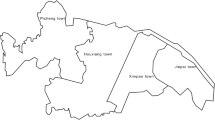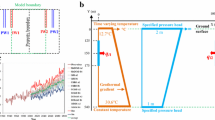Abstract
Thermal breakthrough is the main factor that affects the long-term efficiency of groundwater heat pump systems that predominantly for heating, particularly in northern China. A large water-source heat pump engineering project in Tangshan, China, is examined in this study. The project involves 18 pumping wells with a yield of 80 m3/h and 40 injection wells, covering a total planning area of 445,000 m2. In the third year, a groundwater monitoring system is installed in 23 wells to monitor the groundwater temperature. A hydrothermal coupling numerical model is established with the non-isothermal multiphase migration software TOUGH2. The model is analyzed by applying it to simulations. Simulation results are validated through a comparison with monitoring data. Results of the 10-year operation simulation show that the A3 and A4 well groups experience severe cold accumulation. Three optimization scenarios are thus presented to improve the groundwater temperature. Simulation results show that using the aquifer thermal energy storage method could fully meet the future requirements of heating during winter; however, the cost of this method is high. The optimization effect of alternating the pumping and the injection wells is insignificant. Adopting different pumping and injection layers can effectively control the water temperature decrease in the pumping wells; however, the breakthrough of cold plume should be prevented. The results of this study could provide a reference for the numerical prediction of large-scale water-source heat pump engineering projects in northern China.













Similar content being viewed by others
References
Andersson O (1998) Heat pump supported ATES applications in Sweden. Newsletter IEA Heat Pump Centre 16(2):19–20
Bloomquist RG (1998) “Geothermal heat pumps, four plus decades of experience”. Geo-Heat Centre Q Bull (Klmath Falls, Oregon: Oregon Inst Technol) 20(4):13–18
Canc D, Morrison A, Ireland CJ (1998) Operating experiences with commercial ground-source heat pumps-part 2. ASHRAE Trans 104(2A):677–686
China Academy of Building Research (CABR) (2007) Special plan for ground source heat pump technology of Shenyang city of “Eleventh Five-Year” period (in Chinese)
Curtis R, Lund J, Sanner B, Rybach L, Hellstrom G (2005) Ground source heat pumps geothermal energy for anyone, anywhere: current worldwide activity, Turkey, In: Proceedings of the world geothermal congress pp 1–9
Dana M, Douglas J, John T, James M (1980) Ground-water heat pumps: An examination of hydrogeologic, environmental, legal, and economic factors affecting their use, report, US Department of Energy, No. AC01-78CS20060
Daten zur Nürnberg Umwelt/Sonderausgabe, Grundwasser-bericht 2011, Stadt Nürnberg Umwelt, Lina-Ammon-Strasse 28, 90471 Nürnberg, Germany
Ferguson G (2012) Characterizing uncertainty in groundwater-source heating and cooling projects in Manitoba, Canada. Energy 37:201–206
Gehlin S (2002) Thermal response test-method development and evaluation, Luleå University of Technology (Ph.D. Thesis)
Händel F, Liedl R, Fank J, Rock G (2013) Regional modeling of geothermal energy systems in shallow aquifers: the Leibnitzer Feld case study (Austria). Environ Earth Sci 70:3433–3446
Hatten MJ (1992) Groundwater heat pumping: lessons learned in 43 years at one building. ASHRA Trans 98(1):1031–1037
Holihan P (1998) Analysis of geothermal heat pump survey data. Energy information administration/renewable energy: issues and trends, Washington, D.C, pp 59–66
Ingersoll LR, Plass HJ (1948) Theory of the ground pipe heat source for the heat pump. Heat Pip Air Cond 20(7):119–122
Li H, Yan W (2008) Energy saving inject “green” life into olympic venues. Guangming daily (in Chinese)
Liang J, Yang QC, Liu LC (2011) Modeling and performance evaluation of shallow ground water heat pumps in Beijing plain, China. Energy Build 43:3131–3138
Liu Y (2015) List of the national air worst 10 cities in 2014 [DB/OL]. http://news.iqilu.com/shandong/yuanchuang/2015/0202/2299521.shtml. (in Chinese)
Luo J, Rohn J, Bayer M et al (2014) Analysis on performance of borehole heat exchanger in a layered subsurface. Appl Energy 123:55–65
Ma Z, Lv Y (2006) Design and application of ground source heat pump system. China Machine Press (in Chinese)
Masciale R, De Carlo L, Caputo MC (2015) Impact of a very low enthalpy plant on a costal aquifer: a case study in Southern Italy. Environ Earth Sci 74:2093–2104
Meyer CF, Todd DK (1973) Heat storage wells. Water Well J 27(10):35–41
Pruess K, Oldenburg C, Moridis G (1999) Lawrence Berkeley National Laboratory, TOUGH2 User’ s guide. Berkeley, CA, USA: Version 2.0
Rabbimov RT, Umarov GY, Zakhidov RS (1971) Storage of solar energy in sandy-gravel ground. Geoliteknika 7(5):57–64
Ramos EP, Breede K, Falcone G (2015) Geothermal heat recovery from abandoned mines: a systematic review of projects implemented worldwide and a methodology for screening new projects. Environ Earth Sci 73:6783–6795
Raymond J, Lamarche L (2013) Simulation of thermal response tests in a layered subsurface. Appl Energy 109:293–301
Russo SL, Civita MV (2010) Hydrogeological and thermal characterization of shallow aquifers in the plain sector of Piemonte region (NW Italy): implications for groundwater heat pumps diffusion. Environ Earth Sci 60:703–713
Sanner B (2002) Ground heat sources for heat pumps (classification, characteristics, advantages). Course on geothermal heat pumps
Schellschmidt R, Sanner B, Jung R, Schulz R (2007) Geothermal energy use in Germany. In: Proceedings of European geothermal congress pp 1–7
Shijun L, Wenchen L, Baodong X (2006) Present situation and problems on the use of groundwater heat pumps in Beijing. City Geol 1(1):1007–1903 (in Chinese)
Sinnh JB, Foster G, Hunt AW (2000) Represent operating problems of commercial ground source and groundwater-source heat pump. ASHRAE Trans 106(2):561–568
Tang X (2007) Some suggestions on application of ground source heat pump. China construction heating & refrigeration 7:12. (in Chinese)
Tsang CF, Lippmann MJ, Goranson CB, Witherspon PA (1977) Numerical modeling of cyclic storage of hot water in aquifers, presented AGU Fall Meeting, San Francisco, California, December 6–10, 1976 (LBL-5929)
Vanhoudt D, Desmedt J, Van Bael J et al (2011) An aquifer thermal storage system in a Belgian hospital: long-term experimental evaluation of energy and cost savings. Energy Build 43(12):3657–3665
Wagner V, Bayer P, Kübert M et al (2012) Numerical sensitivity study of thermal response tests. Renew Energy 41:245–253
Warman JC, Molz FJ, Jones TE (1976) Step beyond theory-aquifer storage of energy, Proceedings second southeastern conference on application of solar energy (CONF-769423), NTIS
Wu Q, Xu S, Zhou W et al (2015) Hydrogeology and design of groundwater heat pump systems. Environ Earth Sci 73:3683–3695
Zeghici RM, Damian A, Frunzulica R et al (2014) Energy performance assessment of a complex district heating system which uses gas-driven combined heat and power, heat pumps and high temperature aquifer thermal energy storage. Energy Build 84:142–151
Zhang Q, Wang J (2003) Research and development and practical problem analysis of ground source heat pump and groundwater source heat pump. Fluid machinety 5:50–54 (in Chinese)
Zhang KN, Yu SW, Pruess K (2008) User’s Guide for TOUGH2-MP: a massively parallel version of the TOUGH2 code. Lawrence Berkeley National Laboratory, Berkeley
Zhang Q, Zhang Y, Gao P et al (2014a) Effect of natural cold source on groundwater source heat pump according to laboratory and field geotechnical thermal physical tests. Energy Build 84:557–566
Zhang YJ, Gao P, Yu ZW et al (2014b) Characteristics of ground thermal properties in Harbin, China. Energy Build 69:251–259
Zhou X, Gao Q, Chen X et al (2015) Developmental status and challenges of GWHP and ATES in China. Renew Sustain Energy Rev 42:973–985
Zheng K, Fang H, Wang L (2005) Bacterial growth in a groundwater source heat pump system. J Tsinghua University (Sci Technol) 45(12):1608–1611
Acknowledgments
This study was supported by the China Postdoctoral Science Foundation (No.2014M551190) and Geological Survey project from Ministry of Land and Resources of China (Grant No.1212011120048).
Author information
Authors and Affiliations
Corresponding author
Rights and permissions
About this article
Cite this article
Yu, Z., Zhang, Y., Hao, S. et al. Numerical study based on one-year monitoring data of groundwater-source heat pumps primarily for heating: a case in Tangshan, China. Environ Earth Sci 75, 1070 (2016). https://doi.org/10.1007/s12665-016-5868-y
Received:
Accepted:
Published:
DOI: https://doi.org/10.1007/s12665-016-5868-y




